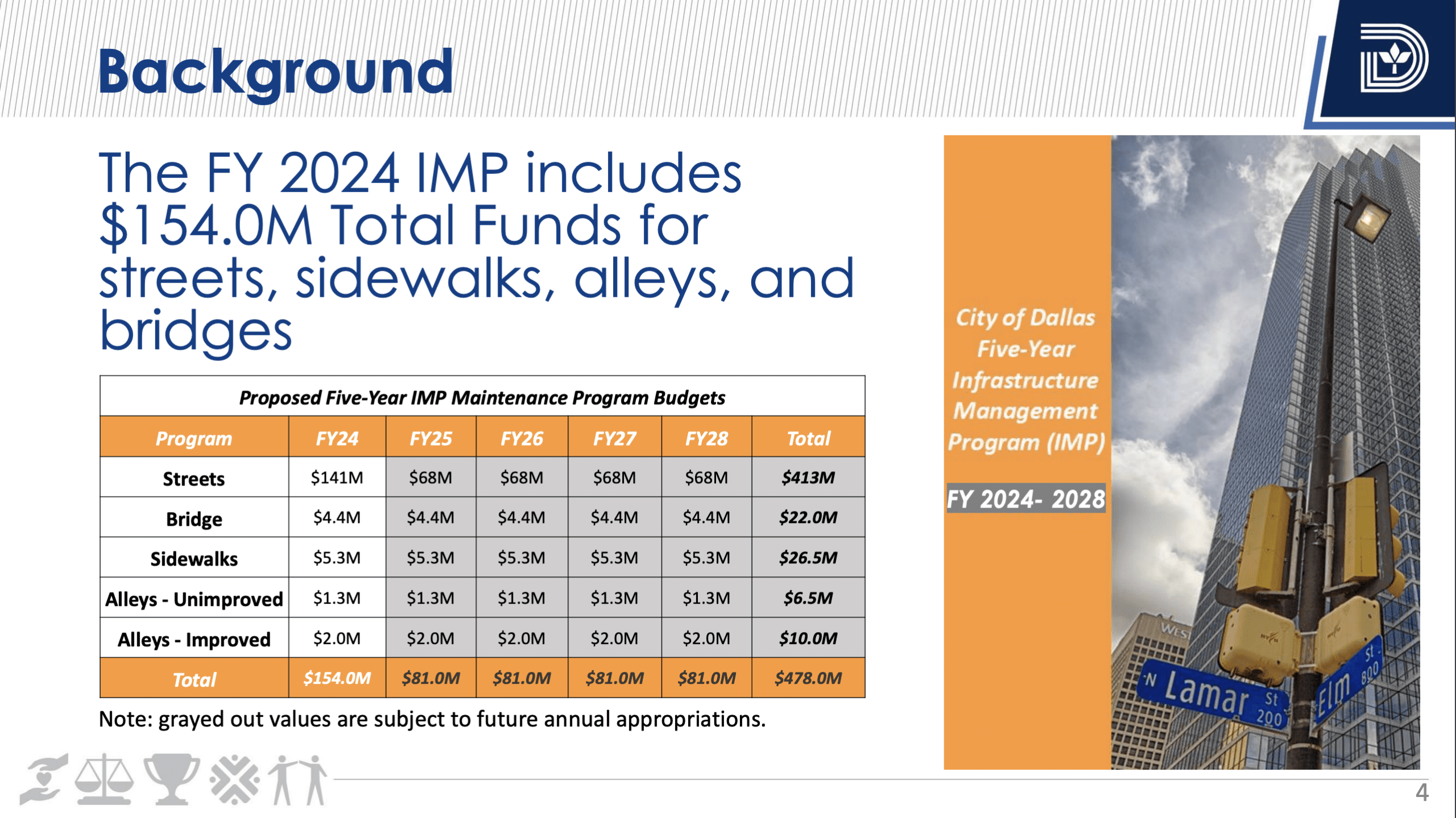In an overview of Dallas’ five-year Infrastructure Management Program on Wednesday, city council members stressed the need for additional funding for street maintenance and questioned whether some districts are getting the help they need.
They addressed Ali Hatefi, director of Dallas’ Department of Public Works, regarding his presentation of a proposed budget for the Infrastructure Management Program (IMP).
“Mr. Hatefi, at the risk of stating the obvious, my District 14 has the highest, greatest property valuation in the city and, as a result, has the highest, greatest property taxes in the city,” Council Member Paul Ridley said. “And yet … I see that District 14 has the worst streets in the city — not arguably — but by five PCI points, as your own data indicates.
“Not only that, but we’re projected not to improve at all in the next five years but remain in the cellar of all 14 districts. How do you explain that?”
PCI stands for Pavement Condition Index — a model used by the public works department to determine which streets are prioritized for annual maintenance.
“The focus is on … the entire city and not each council district, specifically,” Hatefi said. “For now, our focus is for the entire city.”
According to data from the public works department, the average district PCI is 71.5. In District 14, the PCI is 63 and is projected to stay at that level through 2028. The average district PCI is expected to drop to 69.6 over the same period.
The PCI is rated on a 0-100 scale. Streets with “A” ratings fall in a PCI range of 100-85. Those rated “B” are in a PCI range of 70-84.9. For “C” streets, the range is 55-69.9, and “D” streets are in the 40-54.8 range. Streets with “F” ratings fall in the range of 0-39.9.
“I would like to think that there’s some recognition for the need to bring up the lowest … PCI-rated streets that most people in the entire city utilize,” Ridley said. “What do you do to bring us closer to at least the city average in District 14?”
Hatefi again said the public works department is not concerned about how many streets need resurfacing or replaced in each specific district but those that require maintenance across the city over the next five years.
“But there are other factors also to look at if a street is in good shape,” Hatefi said. “Can [people] get from A to B? There are other factors we need to look at. Our reality is what you see on the left side [of the presentation],” he said, referencing a chart proposing an IMP budget of $478 million over five years, from FY 2024 through FY 2028.
The left side of the presentation chart showed the proposed $154 million budget for FY 2024, with $141 million allocated to street maintenance and the remaining $13 million allocated to bridges, sidewalks, and alleyways.

IMP funding comes from tax dollars collected by the City. Separately, the $1.25 billion bond package that Dallas residents will vote on in the upcoming May election contains an additional $521.2 million allocation for streets and transportation.
The bond, if passed, combined with the proposed City IMP funds, would give the Department of Public Works a budget of more than $815 million for street maintenance and repairs over the next five years. However, that amount is still not sufficient to bring all city streets up to good condition, according to officials from the department.
“We should also consider the traffic flow on those streets,” Ridley said. “I would suggest to you that, because you have heavy traffic loads on our streets, … the poor condition is affecting more people than just my district. It’s affecting all the districts. I would suggest you consider that.”
Council Member Gay Donnell Willis (D13) agreed.
“I would like to build on that same thought,” she said. “You said zero degradation is difficult to achieve with a network of our size, and I don’t like that. Our size is our size. We’ve got our budget, and then we’ve got our bond. This really speaks to a need for additional sources of funding. How are we going to get there?”
Willis’ remarks referred to comments by program administrator Shahad Mohammad, who suggested multiple times how costly it would be for Dallas to reach that goal.
Mohammad said that achieving “zero degradation” would require “$125 million per year” in addition to existing funding. Although the department’s proposed budget over five years is more than $815 million for street maintenance and repair, achieving zero degradation would apparently require a budget of $1.36 billion.
“What is our strategy?” Council Member Paula Blackmon (D9) asked. “Is 80 good? Is 70 good? What is the number to shoot for?”
Mohammad said that “anything 60 and above” is considered a fair rating, meaning the average street in Dallas is in fair condition. But Blackmon and others wondered on Wednesday whether public works officials could use different models to evaluate street conditions differently based on location.
“We can ask the system to provide a model,” Mohammad said. “We can ask it to provide different kinds of analysis. But we have to also be aware there are going to be large variances.”
“This is not a one-size-fits-all approach,” said Council Member Omar Narvaez (D6), the City’s Transportation & Infrastructure Committee chair. “We’re going to have to look at this because we have other areas … we’re going to have to take care of. We want it all. It’s just not going to happen. Hopefully, the voters will vote for the bond election.”
“Our streets didn’t fall apart overnight,” Narvaez said. “I tell people the same thing: I didn’t gain weight overnight. I’m not going to lose weight overnight. It’s something we have to get to.”


